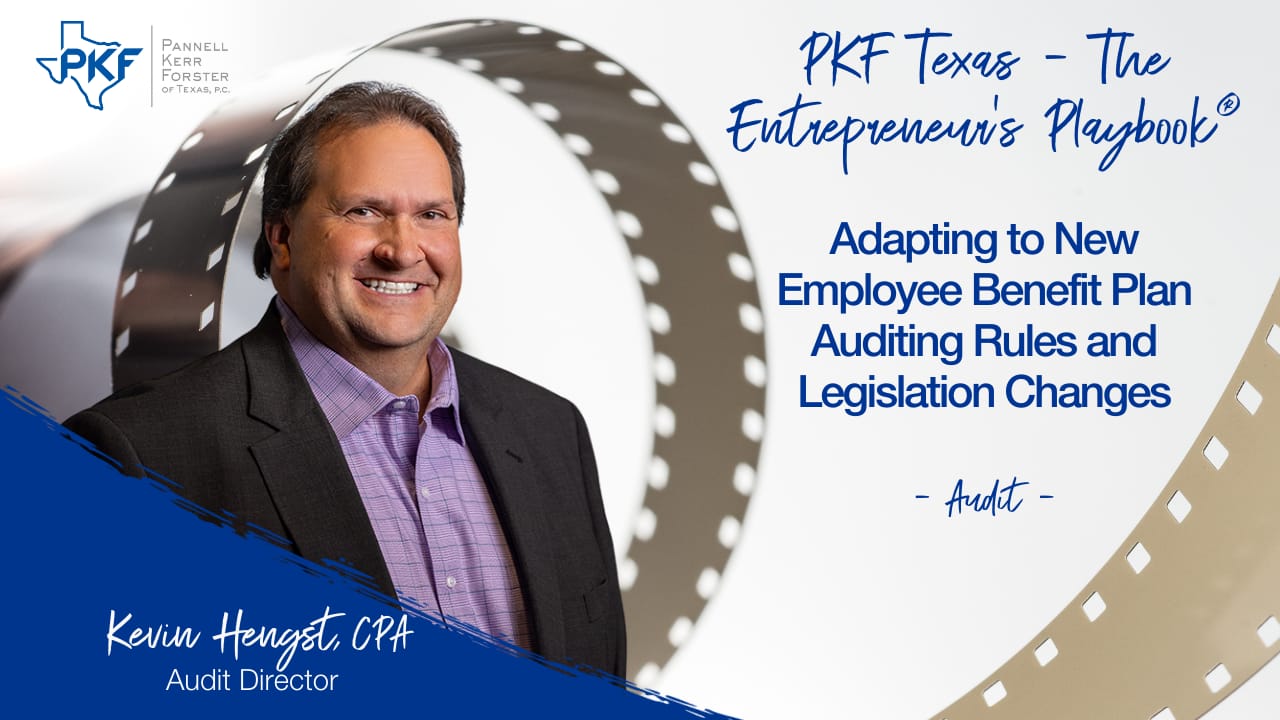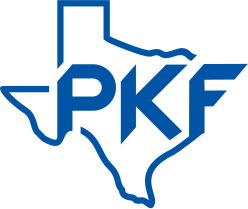Adapting to New Employee Benefit Plan Auditing Rules and Legislation Changes

Join us as Jen Lemanski and Kevin Hengst, CPA, Audit Director, discuss the significant updates in Employee Benefit Plan Audits for plans with a 2023 year-end. Explore the changes in required minimum distributions, force-out provisions, and distribution requests that could reshape retirement savings for participants and influence plan sponsors’ decision-making. Stay informed on the latest developments in employee benefit plans.
Jen: This is the PKF Texas Entrepreneur’s Playbook, I’m Jen Lemanski, and I’m here with Kevin Hengst, an audit director and the head of our Employee Plan Benefit practice. Kevin, welcome to the Playbook.
Kevin: Thank you. Glad to be here.
Jen: With our EBPs or employee benefit plan audits. I know periodically there are new accounting and auditing changes that come down the pike. You know, what are some new ones that folks should be aware of and does legislation have any impact on those changes?
Kevin: Good news for our plan sponsors is for 2023 there will be no accounting changes that they have to incorporate. For auditing, there will be three new standards that came into place. 143 will affect accounting estimates. 144 will deal with specialist and pricing. But the one that will affect auditors the most will be 145, which deals with risk assessment. This will probably not sustainably change the audits that the plan sponsors are experiencing. However, the auditors will have to document a little bit differently to be in compliance with the new standard. The big changes though, and where plan sponsors are going to be most excited will happen with the legislation. The number one rule thing that will happen, a lot with our small companies is the 4-5500 has changed the auditing requirement and how they define participants. It used to be defined as anybody who is eligible to be in a plan. And for 2023, it is now only participants who have an account balance.
Jen: Okay. So that is a little bit of a difference.
Kevin: Yes. The DOL anticipates is, that’ll be about 13,000 audits that will no longer be required for plan sponsors. Which should for the small employers should have an impact. You know, as well. The other big change that plan sponsors will be dealing with is in December of 2022 Congress had passed Secure Act 2.0 in late December. Kind of when I noticed, with the timing as it happened after Christmas. But it has a lot of impact, 92 provisions in total. First of all, Secure 2.0 is great. I mean, the intent of it is obviously to make retirement savings easier for participants as well as easier for plan sponsors to administer. However, with the multiple provisions, you know, TPAs and service providers have to get into coordinates. Probably the hot topics, there’s 92 provisions but the one ones that we’re seeing the most traction with, deal with required minimum distributions. Plan sponsors should be aware of that with the biggest impact. One being that force out provisions, which were at $5,000 can now be raised to $7,000.
Jen: Oh wow. That’s a, that’s a difference.
Kevin: Yes. And with the change for reporting requirements now being participants with account balances, the more that some of these smaller plans can force out, they may actually drop below the audit threshold and have additional cost savings. We’re also seeing traction with Secure 2.0 in regards to distribution requests. It has allowed more events primarily related to disasters to be penalty tax free. There also is a clause in there that allows more for self-certification, which I do want to make clear because this will always come up in our audits, it is perfectly fine for a plan sponsor to self-certify for hardship distribution or one of these other disaster distributions. However, there is a clause in there that if you do self-certify, the participant must still be able to produce the supporting documentation if requested for an audit and such. What we’re finding in practice is a lot of these people who request a hardship distributions tend to leave the company and they may not be available to provide that documentation.
Jen: To say, Hey, here’s all my, here’s all my paperwork.
Kevin: Exactly. So and so then it still falls back on a plan sponsor that they ultimately should have, you know, while they, you can self-certify, they still have to be able to provide that information.
Jen: They still want to document.
Kevin: You still want to maintain the documentation. So yes, you can self-certify, but yes, there’s still could potentially be a documentation requirement. Another thing we’re seeing with Secure 2.0, which will affect some of our plan sponsors is the definition for long-term part-time employees could now be eligible for these plans. That provision won’t go in effect until 2024, but they probably need to start looking at if they have part-time employees, do they qualify and will they maybe be eligible for the plan in upcoming years? And then you’re also seeing the IRS has made it easier with the employee plan compliant resolution system for companies to self-report if they have operation deficiencies and making it easier to do that.
Jen: Good. Good.
Kevin: And finally, to a lesser degree, there is automatic enrollment which will go in effect for new plans in 2025. So again, not currently on the things.
Jen: Something to keep an eye on.
Kevin: Keep an eye on, as well as catch up contributions have a few different criteria that employers probably should be aware of as we head into the 2024 calendar season.
Jen: And it’s still about a hundred employees is where that threshold is to have a plan audited?
Kevin: The threshold is a hundred employees, but again, with the change, it’s going to be participants with the count balances. So again, a very significant change. And like I said, about 13,000 plans will be affected.
Jen: Perfect. Well, I know I’ve got some more questions, but we’ll get you back to talk about those in another video. Sound good?
Kevin: Sounds great. Appreciate it.
Jen: This has been another Thought Leader production, brought to you by PKF – Texas the Entrepreneur’s Playbook. For more information about this and other topics, visit pkftexas.com/insights. Tune in next week for another chapter.
